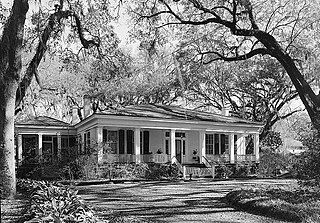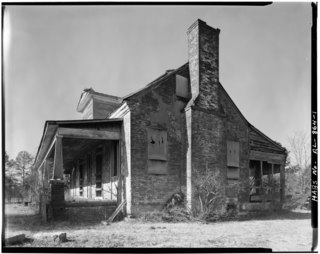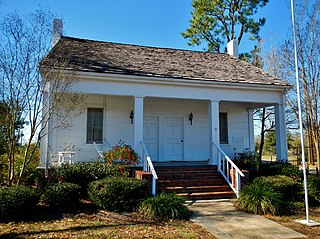
Creole cottage is a type of vernacular architecture indigenous to the Gulf Coast of the United States. The style was a dominant house type along the central Gulf Coast from about 1790 to 1840 in the former settlements of French Louisiana in Alabama, Louisiana, and Mississippi. The style is popularly thought to have evolved from French and Spanish colonial house-forms, although the true origins are unclear.

Ashe Cottage, also known as the Ely House, is a historic Carpenter Gothic house in Demopolis, Alabama. It was built in 1832 and expanded and remodeled in the Gothic Revival style in 1858 by William Cincinnatus Ashe, a physician from North Carolina. The cottage is a 1+1⁄2-story wood-frame building, the front elevation features two semi-octagonal gabled front bays with a one-story porch inset between them. The gables and porch are trimmed with bargeboards in a design taken from Samuel Sloan's plan for "An Old English Cottage" in his 1852 publication, The Model Architect. The house is one of only about twenty remaining residential examples of Gothic Revival architecture remaining in the state. Other historic Gothic Revival residences in the area include Waldwic in Gallion and Fairhope Plantation in Uniontown. Ashe Cottage was added to the Alabama Register of Landmarks and Heritage on August 22, 1975, and to the National Register of Historic Places on 19 October 1978.

The South Lafayette Street Creole Cottages is a grouping of three historic Creole cottages on South Lafayette Street in Mobile, Alabama, United States. They were built in 1852. All three were placed as a group on the National Register of Historic Places on November 7, 1976.

Altwood is a historic plantation house located near Faunsdale, Alabama. It was built in 1836 by Richard H. Adams and began as a log dogtrot house. It was then expanded until it came to superficially resemble a Tidewater-type cottage. Brought to the early Alabama frontier by settlers from the Tidewater and Piedmont regions of Virginia, this vernacular house-type is usually a story-and-a-half in height, displays strict symmetry, and is characterized by prominent end chimneys flanking a steeply pitched longitudinal gable roof that is often pierced by dormer windows.

The William King Beck House, also known as River Bluff Plantation, is a historic plantation house on the Alabama River near Camden, Alabama. The main house was built in 1845 for William King Beck and is attributed to architect Alexander J. Bragg. William King Beck was an attorney from North Carolina who migrated to Wilcox County in the 1820s. He was the nephew of William Rufus King, the 13th Vice President of the United States.

The Snow Hill Normal and Industrial Institute, also known as the Colored Industrial and Literary Institute of Snow Hill, was a historic African American school in Snow Hill, Alabama. It was founded in 1893 by Dr. William James Edwards, a graduate of Tuskegee University, and began in a one-room log cabin. The school grew over time to include a campus of 27 buildings, a staff of 35, and over 400 students. The school was operated as a private school for African-American children until Dr. Edward's retirement in 1924, when it became a public school operated by the State of Alabama. The school closed in 1973, after the desegregation of the Wilcox County school system. Out of the original 27 buildings, only eight survive today. They range in architectural style from Queen Anne to Craftsman and include the founder's home, five teachers' cottages, and the library. The National Snow Hill Alumni Association and the local Snow Hill Institute supporters determined to save the remaining structures in 1980. In June 1980, Dr. Edwards' granddaughter and Snow Hill alumna Consuela Lee Moorehead reopened the school as the Springtree/Snow Hill Institute for the Performing Arts and ran after-school and summer programs for local students. The art institute continued to run until 2003 when Moorehead's declining health caused her to close down the school. The school was listed on the National Register of Historic Places on February 24, 1995.

The U. J. Cleveland House is a historic house located at 551 Charles Street in Mobile, Alabama. It is locally significant as an intact Gulf Coast Cottage with an unusual interior plan.

Georgia Cottage, also known as the Augusta Evans Wilson House, is a historic residence in Mobile, Alabama, United States. It was added to the National Register of Historic Places on September 14, 1972, based on its association with Augusta Jane Evans. She was one of the most popular American novelists of the nineteenth century and the first female author in the United States to earn over $100,000 for her work, but has been largely forgotten in recent times.

The Hawthorn House is a historic house in Mobile, Alabama, United States. The 1+1⁄2-story wood-frame structure, on a brick foundation, was built in 1853 in the Gulf Coast Cottage style by Joshua K. Hawthorn. It was placed on the National Register of Historic Places on May 21, 1984, based on its architectural significance.

The Wilson–Finlay House, also known as Mist Lady, the Joshua Wilson House, and the Finlay House, is a historic plantation house in Gainestown, Alabama. It was added to the Alabama Register of Landmarks and Heritage on September 17, 1976. It was placed on the National Register of Historic Places on July 12, 1978, due to its architectural significance.

The Lowndesboro Historic District is a historic district in Lowndesboro, Alabama, United States. It was placed on the National Register of Historic Places on December 12, 1973. The district covers 1,800 acres (730 ha), spread over the entire town, and contains 20 contributing properties, including Meadowlawn Plantation. Architectural styles include the Gothic Revival, Greek Revival, and other Victorian styles.

Halifax Historic District is a national historic district located at Halifax, Halifax County, North Carolina, US that was listed on the National Register of Historic Places in 1970 with an increase in 2011. It includes several buildings that are individually listed on the National Register. Halifax was the site of the signing of the Halifax Resolves on April 12, 1776, a set of resolutions of the North Carolina Provincial Congress which led to the United States Declaration of Independence gaining the support of North Carolina's delegates to the Second Continental Congress in that year.

The Green Pryor Rice House is a historic residence in Somerville, Alabama. The house was built in the early 1830s by Matthew Cyrus Houston, a Virginian who was postmaster of Somerville and clerk of the circuit court. In 1837 the house was acquired by Green Pryor Rice, a judge and state senator. Two of Rice's grandsons who were born in the house also went on to political careers: Samuel D. Weakley was Chief Justice of the Alabama Supreme Court and Malcolm Rice Patterson was Governor of Tennessee. The house is a Tidewater cottage, native to the southern Atlantic coast. The house is constructed of Flemish bond brick, and has two front entries, each with transoms. An unusual feature of the house is the corbelled brick cornice. A bungalow-style porch was added in 1927, but removed in 1984. The house was listed on the National Register of Historic Places in 1986.

The Peter F. Armistead Sr. House is a historic residence near Florence, Alabama. The land was purchased by Peter Fontaine Armistead in 1818, with the house built around 1825. The exterior is a near copy of Armistead's home in Culpeper County, Virginia, "Glen Ella". Thomas S. Broadfoot purchased the house in 1877, who sold it to Howard Wright in 1935. The house underwent restoration in the 1970s. The house is five bays wide, with steps leading up to a narrow, flat-roofed entry portico. There are three dormer windows protruding from the gable roof on the front and rear. The interior is laid out in a double-pile configuration, with a parlor behind the front stair hall. A kitchen wing was added to the northwest rear in the 1970s. The house was listed on the Alabama Register of Landmarks and Heritage in 1978 and the National Register of Historic Places in 1986.

The William Koger House is a historic residence near Smithsonia, Alabama. The house was built around 1830 by William and Martha Koger, planters from Virginia. The Kogers brought their native architectural form, the Tidewater-type cottage, with them to North Alabama. The house was the center of a 630-acre (255-ha) plantation, which included an island in the Tennessee River. After William's death, Martha continued to manage the farm until her death in 1892.

The John Johnson House also known as The Green Onion is a historic residence near Leighton, Alabama, USA. The house was built in the late 1820s by John Johnson, a settler from Mecklenburg County, Virginia, who lived in Middle Tennessee before coming to North Alabama. His son-in-law, Lewis Dillahunty, was one of the earliest settlers in the western Tennessee Valley, and convinced Johnson to move to the area. Johnson died in the early 1840s, and his son sold the house and 80 acres out of the family. The house has been long occupied by tenant farmers, and is now part of the Leonard Preuitt estate.

The Kennedy House is a historic residence in Abbeville, Alabama. The house was built around 1870 by William Calvin Bethune, a local physician. The house changed hands several times before being acquired by William and Mollie Kennedy in 1885. The Kennedys, who were Henry County farmers, used it as a town house. It remained in the family until 1974, when it was purchased by the local Board of Education. The house was later owned by the Abbeville Chamber of Commerce.

The Samuel Lawson Dowling House is a historic residence in Ozark, Alabama. The house was built in 1870 by Samuel Lawson Dowling, whose family was one of the first groups to settle in Dale County, Alabama. Lawson's grandfather, Dempsey, was a Methodist minister who came to the Wiregrass Region from Darlington County, South Carolina, and helped found Claybank Church near Ozark. Samuel was a farmer, county treasurer, and construction contractor who built the first Methodist church in town.

















